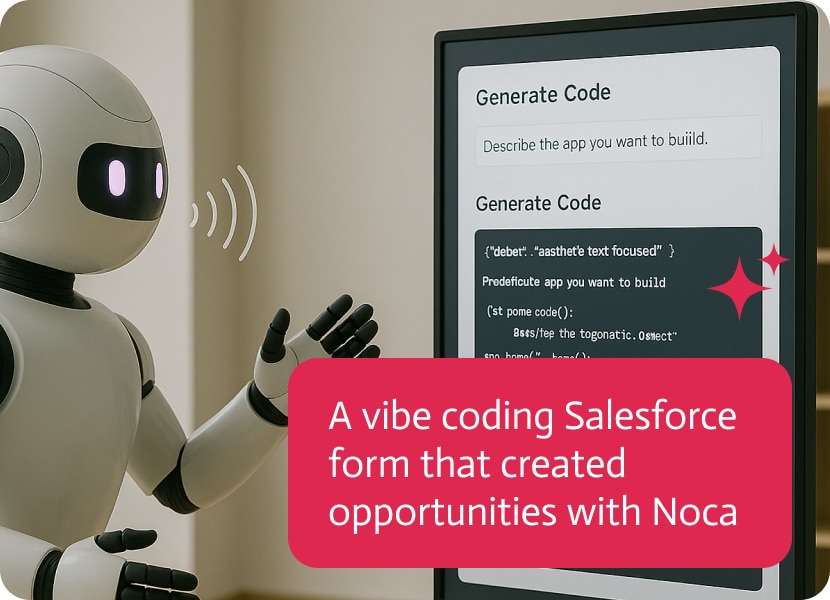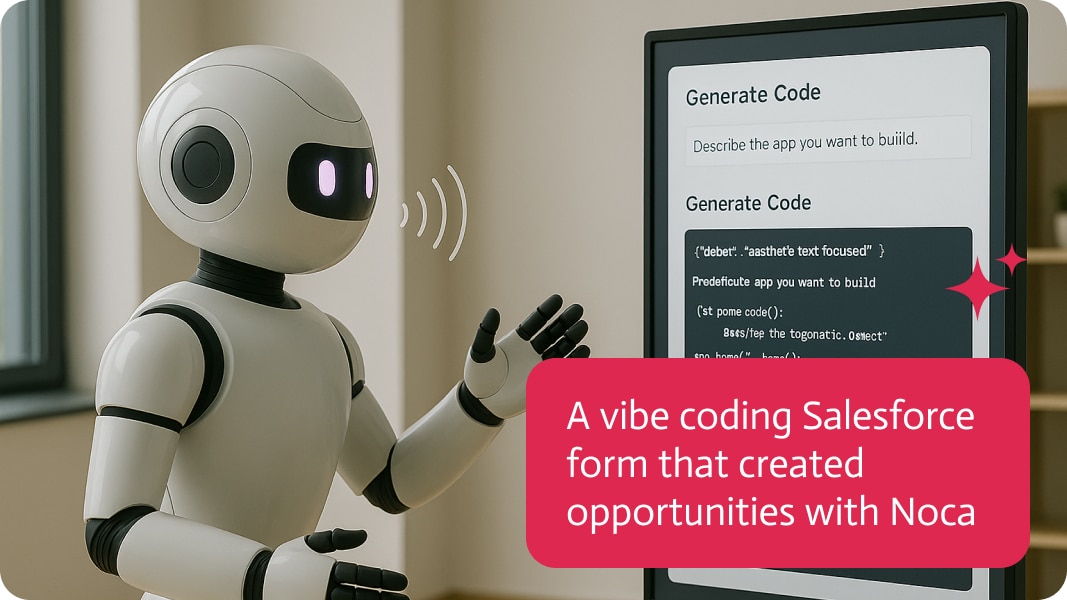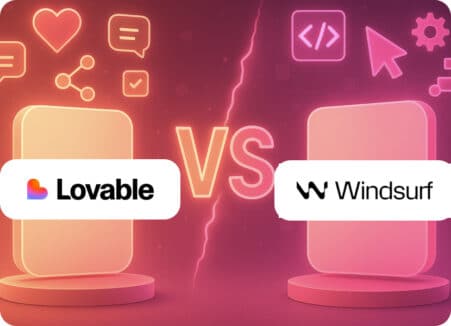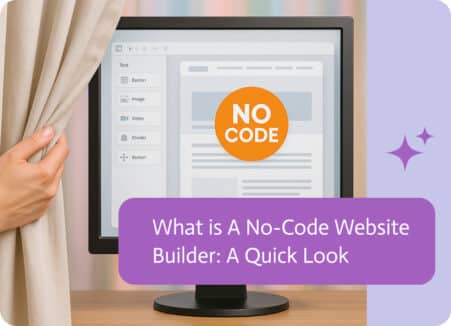

Vibe Coding A Salesforce Form That Creates Opportunities with Noca
If you’ve ever tried to get Salesforce to bend to your will, you know it can feel like wrangling a wild horse while someone shouts obscure acronyms at you from across the paddock. Forms, workflows, permissions, integrations, it’s powerful, but it’s also dense. Traditionally, building something as simple as a custom form that creates an opportunity in Salesforce could involve hours of setup, fields mapping, API wrangling, and maybe a little prayer every now and then.
That’s where Noca and its vibe coding approach come into play. Now, there is no need to mess around with syntax, configuration screens, or developer resources, you tell Noca what you want, literally, in plain English. The system takes your intent and transforms it into working code and logic. It’s like skipping the part where you learn a whole new language just to make Salesforce do something obvious, like “when a customer fills out this form, create an opportunity.”
This shift doesn’t just save you time, it’s revolutionizing how we build, deploy, and scale business tools. Let’s see how this actually works, why it’s a big deal, and the opportunities it unlocks for companies of all sizes.
The Old Method: Painfully Manual Configuration
Salesforce has long been the gold standard of a CRM. Its flexibility is powerful but also frustrating sometimes, almost like it’s Achilles’ heel. Yes, it can handle nearly any sales process imaginable, but configuring it often feels like slogging through wet cement.
Building a form that feeds directly into Salesforce opportunities, you’d typically do:
- Build a form through Salesforce itself (or a connected tool like Web-to-Lead).
- Configure fields so the data actually lands in the right objects.
- Establish workflows, AI automations, and user rights to make sure opportunities are created properly.
- Embed the form into your website, usually requiring developer help.
- Test, debug, and the redo until the process finally works the way you wanted it to.
This workflow could stretch into days or weeks, and will often depend on how tech-savvy your team is. And if you needed custom logic, say, automatically tagging opportunities with a campaign ID or sending them to a specific sales team, it gets even more complicated
For many smaller teams, this meant either hiring a Salesforce consultant or resigning themselves to a generic, rigid form builder with limited Salesforce integration.
Vibe Coding Salesforce Form Automation
Noca’s Vibe coding and AI agent platform flips this traditional workflow on its head. Instead of treating configuration as a maze of technical jobs, it’s turned it into a conversation.
Imagine you sit down with a developer and say:
“I need a simple form for our website. When someone fills it out, I want a new Salesforce opportunity to be created, linked to that contact. Also, make sure we capture their budget, preferred timeline, and source campaign.”
With Noca, you type that straight into the platform. The AI parses your intent, comes up with the necessary form structure, handles Salesforce’s API logic, and even provides you with an embed code to drop onto your website. The back-and-forth is conversational, not technical. If you realize you forgot a detail, you just tell Noca:
“Actually, add a dropdown for industry and make it a required field.”
Seconds later, it’s done. No API documentation. No hunting through Salesforce’s Object Manager. No endless field-mapping checklists.
How Vibe Coding Automates Salesforce Forms
While the user experience feels like magic, under the hood, there’s a lot happening.
- Natural Language Understanding: Noca interprets the intent. Saying “a form that creates a Salesforce opportunity” it translates to specific requirements: create a form object, tie it to the Opportunity object in Salesforce, and ensure field mappings align.
- Dynamic Schema Mapping: Salesforce orgs aren’t uniform, your setups will often have custom fields, unique validations, or required fields on Opportunity objects. Noca automatically detects these and adjusts its setup to match.
- Generate Code Automatically: Instead of stitching prebuilt modules together, it builds what it needs as directed, so it can adjust for special situations, custom actions, and different data setups.
- Deployment and Embedding: Once configured, Noca outputs a usable form that you can put directly onto a website or app. The connection to Salesforce is already wired in, so the info goes right from the form to your CRM.
The result: you get an enterprise-grade integration without touching a line of Apex code or messing with Salesforce’s sometimes opaque UI.
Why It’s Important for Sales Teams
So you’re probably thinking: “Okay, so it saves some time. So what?” But it makes a huge difference.
Faster Lead Capture
In sales, timing is everything. If a lead submits a form and it takes hours (or days) for the opportunity to be manually created or synced, you risk losing that lead’s interest. With a Noca-powered form, the opportunity appears in Salesforce instantly, ready for a rep to act.
Development Democratization
Non-technical staff, like marketing managers, sales ops, even founders can now spin up working Salesforce integrations without pulling in a developer or admin. That removes barriers and keeps projects moving.
Consistency and Accuracy
Manual configuration often tends to produce inconsistencies, missed fields, mismatched logic, or forgotten validations. Noca’s automated mapping makes sure that every submission is treated the same way, reducing data errors and cleanup work later.
Scalability
Need another form for a different campaign? Want to tweak the logic to support regional sales teams? You can adjust it in minutes. That kind of flexibility keeps your Salesforce instance agile instead of being inundated by technicalities.
Gain Sales Efficiency with Vibe Coding Forms
Adopting a vibe coding approach through Noca does more than just save time, it shifts a businesses operational DNA. By letting anyone use these building tools, experimentation is encouraged. Marketing can launch more campaigns because forms are easy to build. Sales can test new qualification questions without filing IT tickets.
In a competitive market, that speed determines if you capture leads or lose them. And because vibe coding ensures these tools are directly wired into Salesforce, you’re not dealing with separated data or broken integrations. Everything feeds back into the single source of truth your sales team already lives in.
Advanced Salesforce Forms Using Vibe Coding
Even though the simple “form-to-opportunity” use case is the headline, the uses go much further. A few examples:
- Multi-Step Qualification: Forms that branch based on user answers, automatically routing opportunities to different sales teams.
- Event Registration: Capture attendees, create opportunities, and log event campaigns in Salesforce all in one flow.
- Partner Portals: Partners are allowed to submit deals through a branded form, automatically tagged as partner-sourced opportunities.
- Lead Scoring: Embed logic into the form so submissions are scored and prioritized before hitting Salesforce.
Because vibe coding is conversational, these advanced setups aren’t exponentially harder—they’re just a couple of extra prompt to bot instructions.
Security and Trust Considerations
Whenever you’re connecting external forms to a CRM, keeping data safe is super important. Salesforce carries sensitive customer details, and you don’t want sloppy integrations opening the door to breaches or compliance headaches.
Noca approaches this with enterprise-grade standards: encrypted API connections, respect for Salesforce permission structures, and records every configuration change. Since Noca doesn’t bypass Salesforce’s native security, admins retain control when it comes to data flows in and how it’s handled, giving you complete peace of mind.
How This Affects CRM Customization Going Forward
The Salesforce ecosystem is nothing short of massive, with thousands of consultants, developers, and third-party tools offering ways to bend it to your business. Vibe coding doesn’t replace them, it accelerates what’s possible.
Instead of treating customization as a rare, resource-heavy project, it becomes part of everyday operations. It gives teams the chance to try new workflows, build new entry points, and experiment with customer engagement, all without waiting in line for developers.
This will eventually change how businesses view CRM in general. It transforms into a flexible canvas that is expressed in plain English versus a strict system that needs to be translated between company demands and technical conditions.
Final Thoughts on Salesforce Form Automation
A simple Salesforce form that creates opportunities might not sound revolutionary at first. But when you consider the old way of building it, technical problems, the slow turnaround, and the reliance on specialists, the difference is significant.
With Noca, a single sentence builds an integration that once required days of work. Through AI app generation, intent becomes action without friction. This means speed, agility, and more time spent actually engaging customers instead of configuring software. For teams, it means empowerment, so now they can build what they need when they need it.
And for Salesforce, this signals a future where the platform is even more capable, not because it changes, but because the way we use it does.


